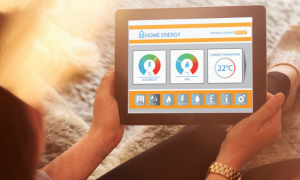Coldwell Banker Real Estate LLCAugust 2015
For PDF copy: View full survey results
Our homes have been hailed as the next thing in our lives to be transformed by smart technology. But is the “smart home” really catching on, or are consumers embracing the “smart-ish” home? Coldwell Banker Real Estate and CNET, the world’s largest and most trusted online source of consumer technology news and reviews, partnered on a joint-consumer survey to examine consumer trends relating to the adoption of smart home technology.
Who Has Smart Home Technology?
More than 1 in 4 U.S. adults (28 percent) have smart home products in their home.
- • Among Millennials (ages 18 to 34), almost half (47 percent) have smart home products in their home.
- • Parents with child(ren) under 18 living at home are almost twice as likely to have smart home products vs. those with no child(ren) under 18 living at home (42 percent of those with child(ren) under 18 living at home vs. 23 percent of those with no child(ren) under 18 living at home).
- • By region, the Midwest appears to lag behind the rest of the country in terms of adoption of smart home products. Across the rest of the U.S., 30 percent have smart home products in their home while among those in the Midwest, this incidence is 22 percent.
How Are People Controlling Their Smart Home Products?
The smartphone truly is the remote control for your smart home.
- • 76 percent of those with smart home products at home are controlling one or more of those products with a mobile device.
- • And 40 percent of those controlling one or more smart home products with a mobile device are actually controlling two or more products via that device.
Can Smart Homes Save You Time?
Is it true that having smart home products in your home saves you time? According to the survey data, it is.
- • 57 percent of Americans who have smart home items say that these products save them time and at an average of almost 30 minutes per day.
- • Although 43 percent of those who have smart home products see no time savings and still spend the same amount of time doing tasks.
- • Those under 45 years of age are more likely to agree that smart home technology is saving them time. Among those ages 18 to 44, 65 percent say it saves time (an average of 31 minutes a day). Among those ages 45 and older, 38 percent say smart home technology saves time (an average of 25 minutes a day).
But Can They Save You Money?
This technology can save you time, but can it save you money too?
- • 45 percent of Americans who have smart home items say that these products save them money and at an average of $98.30 per month. That’s a savings of over $1,100 a year!
- • 55 percent of Americans who have smart home items say their smart home product(s) does / do not save them money.
- • Among Americans ages 18 to 44 who have smart home items, 50 percent say smart home items save them money vs. 33 percent of those 45 and older.
How Are Smart Homes Benefitting Americans?
Smart home technology saves Americans time and money. But what are some other benefits of these products?
- • More than nine in ten (91 percent) of those who have smart home products would recommend smart home technology.
- • 87 percent of those who have smart home products say it makes their life easier.
- • Four in five (81 percent) of those who have smart home products would be more likely to buy a home if smart technology was already installed.
- • And 72 percent of those who have smart home products say smart home product(s) provide them with peace of mind when it comes to home security.
Younger adults are dramatically more attuned to smart home technology and the associated benefits.
Parents of Child(ren) Under 18 at Home and Smart Technology
- • Parents with child(ren) under 18 at home who have smart home products are significantly more likely to say that such products are saving them money: 59 percent of parents with child(ren) under 18 at home vs. only 36 percent of individuals without child(ren) under 18 living at home.
- • Parents with child(ren) under 18 living at home are significantly more likely to have made their home “smart” when they moved in, and significantly more likely to agree that smart home products provide peace of mind when it comes to home security. Specifically:
- 68 percent of parents who own smart home products and have child(ren) under 18 at home agreed that they made their home “smart” when they moved in vs. 50 percent of individuals who own smart home products without child(ren) under 18 living at home.
- 78 percent of parents who own smart home products and have child(ren) under 18 at home say that having those products provides peace of mind, significantly higher than the 68 percent agreeing with the statement among those individuals who own smart home products without child(ren) under 18 living at home.
- • Among all survey respondents, if they were buying a home today, 59 percent of parents with child(ren) under 18 at home say that they would be willing to pay more for a home with smart home technology installed. This incidence is significantly higher than the 47 percent individuals without child(ren) under 18 living at home.
What Room do People Use Smart Home Technology in the Most?
When Americans who own a smart home product were asked which rooms benefits from smart home products, over half (52 percent) cited the living room followed by the bedroom (45 percent), family/rec room (35 percent), kitchen (30 percent) and dining room (21 percent).
What Would Make You Purchase a Smart Home Product?
For Americans who don’t already have smart home technology, there are several factors to consider when deciding what to purchase.
- • 44 percent say they would consider purchasing a smart home product if the technology were less expensive,
- • And 42 percent would consider purchasing a smart home product if it would save them at least $500 yearly on their utility bills and household expenses.
How Much Would Americans Spend on this Technology?
Americans are watching their energy bills and always looking for ways to improve efficiency.
- • Via a one-time purchase, Americans would spend the most on technology that controls heating/cooling efficiency/temperature ($99 on average).
- • Younger adults are more willing to spend considerably more for smart home devices. For example, those under 45 years of age would spend an average of $144 for heating/cooling efficiency/temperature control vs. and average of $59 among those ages 45 and older. A device that could turn the oven on remotely and pre-heat it? Those under age 45 would spend $62 for such a device, as compared to only $9 among those ages 45 and over.
Full Methodology
This survey was conducted online within the United States between June 18-19, 2015 by Harris Poll on behalf of the Coldwell Banker brand and CNET via its Quick Query omniÂbus product. The survey was conducted among 4,043 adults (aged 18 and over) among whom 1,141 own at least one smart home product. For the purposes of the survey, “smart home technology/products” were defined as products or tools that aid in controlling a home’s functions such as lighting, temperature, security, safety, and entertainment, either remotely by a phone, tablet, computer or with a separate automatic system within the home itself. Figures for age, sex, race/ethnicity, education, region and household income were weighted where necessary to bring them into line with their actual proportions in the population. Propensity score weighting was used to adjust for respondents’ propensity to be online.
All sample surveys and polls, whether or not they use probability sampling, are subject to multiple sources of error which are most often not possible to quantify or estimate, including sampling error, coverage error, error associated with nonresponse, error associated with question wording and response options, and post-survey weighting and adjustments. Therefore, the words “margin of error” are avoided as they are misleading. All that can be calculated are different possible sampling errors with different probabilities for pure, unweighted, random samples with 100% response rates. These are only theoretical because no published polls come close to this ideal.
Respondents for this survey were selected from among those who have agreed to participate in our surveys. The data has been weighted to reflect the composition of the adult population. Because the sample is based on those who agreed to participate in our panel, no estimates of theoretical sampling error can be calculated.






